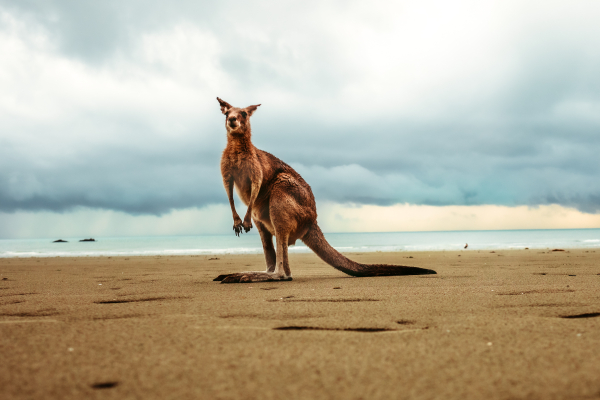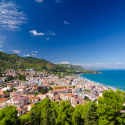Australia: Top Natural Wonders and Must-See Attractions
 Australia is one of the most breathtaking countries globally. With its distinctive landscapes, stunning nature, and rich culture, it’s a perfect travel destination. This article highlights the most essential natural spots you should explore while in Australia. From wine regions to the Great Barrier Reef, tropical areas, rainforests, and national parks, there's something for everyone.
Australia is one of the most breathtaking countries globally. With its distinctive landscapes, stunning nature, and rich culture, it’s a perfect travel destination. This article highlights the most essential natural spots you should explore while in Australia. From wine regions to the Great Barrier Reef, tropical areas, rainforests, and national parks, there's something for everyone.Margaret River: A Haven for Wine Enthusiasts
Margaret River, a quaint town in Western Australia, is renowned for its exquisite wines and beautiful beaches. This area is a paradise for wine lovers who can visit numerous wineries to sample local flavors and learn about the winemaking process. Interestingly, winemaking in this region began relatively late. Although the first winemakers started in the late 1960s, their efforts were mostly home-based and experimental. Experts estimate that by 1985, there were around 500 hectares of vineyards, increasing to 5,500 hectares by 2008, and today there are nearly 5,000 hectares.
Hayman Island: A Tropical Retreat
Australia boasts many beautiful tropical islands perfect for relaxation or engaging in water sports. Hayman Island, situated at the northern end of the Great Barrier Reef, is famous for its pristine beaches and vibrant marine life. The underwater world around the island is spectacular, with sightings of sea elephants, dolphins, and even sharks. Couples can enjoy a romantic moonlit dinner or a beach picnic.
The Great Barrier Reef: A Natural Marvel
Stretching along Australia's northeastern coast in the Coral Sea, the Great Barrier Reef is the world's largest coral reef system. This natural wonder is one of Australia's most famous attractions, and it's no wonder why CNN included it in its list of seven natural wonders. Here, you can observe numerous fish species and other marine creatures, making it an ideal spot for diving and snorkeling to admire breathtaking underwater views.
The Whitsunday Islands: A Must-Visit Archipelago
When in Australia, the Whitsunday Islands are a must-see. This archipelago in the Coral Sea, off the coast of Queensland, comprises about 74 islands. They are known for their water activities like sailing, diving, and windsurfing.
Orpheus Island: An Idyllic Escape
Located off the coast of northern Queensland, Orpheus Island is part of the Palm Islands archipelago. This beautiful location is perfect for exploring the Great Barrier Reef or embarking on your own adventure. Named in the 19th century by Lieutenant J. E. Richards after HMS Orpheus, a Royal Navy ship that wrecked off New Zealand's coast in 1863, the region is popular for island cruises, fishing, and snorkeling.
Kangaroo Island: A Wildlife Sanctuary
Wildlife enthusiasts must visit Kangaroo Island, where they can see not only kangaroos but also koalas, echidnas, and sea lions lounging on the beaches. About 10,000 years ago, the island was part of the mainland but became separated as sea levels rose. Today, it is Australia's third-largest island.
Daintree National Park: A Tropical Paradise
Daintree National Park, often referred to as Daintree Rainforest, is one of the most diverse ecosystems globally and part of the largest continuous area of tropical rainforest in Australia. Located in northern Queensland, this park spans 1,200 km². It has preserved an impressive variety of flora, mammals, birds, reptiles, spiders, insects, and fungi over millions of years. The park, where the landscape with Australia's highest rainfall meets the Coral Sea, also features the world's most diverse mangrove ecosystem. It remains the only extensive continuous tropical rainforest in Australia, extending from the highlands of the Great Dividing Range to the coast, largely unbroken by human development.
The Great Ocean Road: A Scenic Route
The Great Ocean Road is one of Australia's most picturesque routes, stretching nearly 250 km along the southeast coast. Construction began in 1919 to honor soldiers who fought in World War I, taking nearly ten years to complete. Starting in Torquay and ending in Allansford, the route includes popular stops like the surfer’s paradise Bells Beach and the Memorial Arch with the famous Great Ocean Road sign.
Uluru-Kata Tjuta National Park: A Cultural Icon
One of Australia’s most famous national parks, Uluru-Kata Tjuta is a UNESCO World Heritage site located in the Northern Territory. Known for its stunning geological formations, including the iconic Uluru rock, this park holds significant cultural importance for the Aboriginal people. Uluru, standing at 318 meters tall, impresses visitors with its vibrant red hue and spiritual significance.
Kakadu National Park: A Natural Wonderland
Kakadu National Park, covering nearly 20,000 km² in the Northern Territory, is surrounded by dramatic red cliffs and lush eucalyptus forests. Known for its clear emerald-green lakes and majestic waterfalls like Gunlom and Twin Falls, the park is also home to crocodiles hiding among the lotus flowers. Kakadu boasts a vast array of bird species and other wildlife, including numerous waterfowl and wetland birds, making it a paradise for bird watchers. The park is also a sanctuary for 26 species of bats, including four endangered ones, and is home to many honeyeaters found in the forests.









